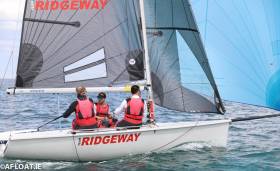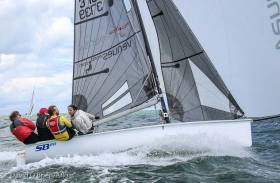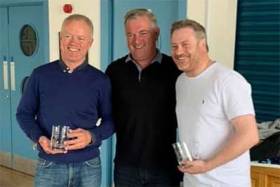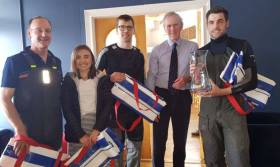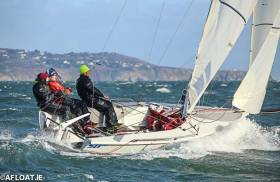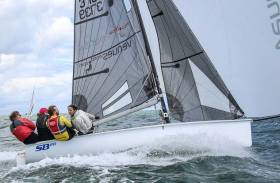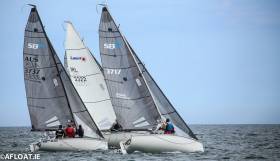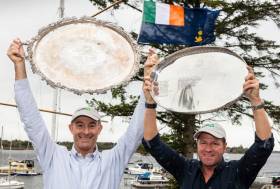Displaying items by tag: SB20
After an opening race win in the Volvo Dun Laoghaire Regatta SB20 Division today, the All-Ireland Sailing Champion Peter Kennedy helming Team Ridgeway could only manage sixth in the second race to place third overall in the 16-boat sportsboats fleet.
The lead is held by Jerry Dowling's Bad Kilcullen who scored 3, 1 In May, the on-form Dowling crew also won the class Northern title on Strangford Lough. Second overall is Alert Packaging, (Chris Helme, Justin Burke & Alan Claffey) of the National YC on five points.
The 16-boat turnout at Dun Laoghaire is a shot in the arm for the class that last month was forced to cancel its Sprint Series due to lack of numbers.
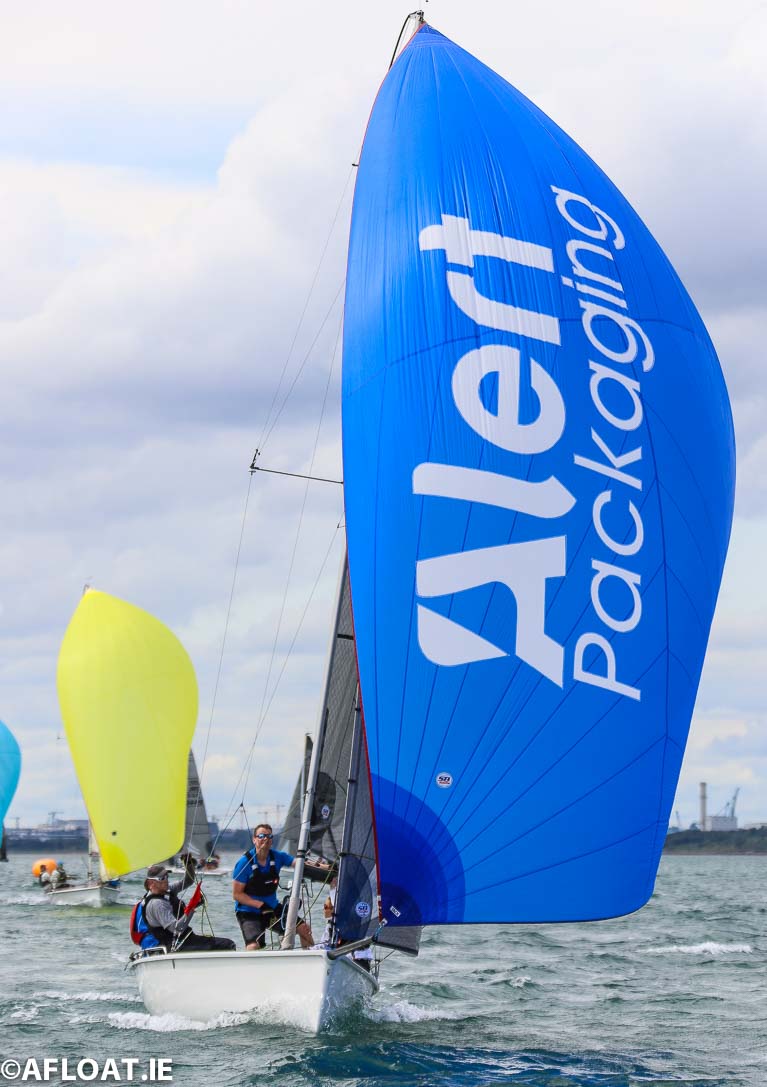 Justin Burke's Alert Packaging lies second Photo: Afloat
Justin Burke's Alert Packaging lies second Photo: Afloat
Lack of Entries Cancels SB20 Sprint Series on Dublin Bay
Saturday's planned SB20 Sprint Series on Dublin Bay has been cancelled.
The aim of the innovative sportsboat series was to run "lots of races back to back" but Class President Colin Galavan said he had no option but to "cancel running the event" due to lack of support.
Thankfully, the class can revert to the regular two DBSC Saturday races scheduled this weekend.
In a communication to the membership, Galavan gave an insight behind the lack of take up for the event, "lots of sailors have just finished the Dun Laoghaire-Dingle race, others are off on holiday after the Leaving and Junior Certs and some are off to Sovereigns Cup".
Meanwhile, Royal Irish SB20 skipper Ger Dempsey (pictured above) finished seventh overall at the North Sea Regatta 2019 in the Hague a week ago. Dempsey sailing with Dublin Bay sailors Chris Nolan, Dion Labouret and Justin Burke were winners of race six in the 13-boat fleet. Results are here.
Four wins from six sealed victory for the Royal Irish Yacht Club team Bád/Kilcullen at last weekend's Strangford Lough-based SB20 Northern Championships.
Jerry Dowling, RIYC's Rear Commodore Sailing, and fellow RIYC Members Stefan Hyde and Jimmy Dowling were in top form in the eight–boat fleet.
Second overall was Michael O'Connor in Ted, with national champion Peter Kennedy of the host club third.
Download results below.
There were so many crew changes at the SB20 Easter Championships in Howth Yacht Club last weekend, the fleet was barely recognisable. Ridgefence, missing Peter Kennedy, was helmed by Emmet Ryan, Bad had Michael O’Connor on the back, venuesworld.com moved Ger Dempsey forward and gave Justin Burke the helm, the Dorans tried a four-man combination for the first time, John Malone was replaced by Alistair Kissane in his new boat, with Diana Kissane on the helm.
It was clear from the start that the podium at this seven-boat championship was open to all.
Race officer, Richard Kissane, delivered six races over the two days with incredible efficiency. Conditions were shifty, but the 20-degree shifts were consistent and the results at the end of the event would suggest the race course remained fair. If you wanted tight racing you got it, the first 4 boats finished within a point of each other after 6 races, with the podium decided on countback.
There is a theory that consistency is the key in a race series, however, this proved wrong for Ridgefence on this occasion. Despite 6 good race results and equal points with Bad and venuesworld.com, they were pushed off the podium on countback. Lofly (12), Bad (13) and venuesworld.com (13) shared the bullets with 2 each and took the prizes.
Thanks to ProvidentCRM and UK Sails Ireland for sponsoring the prizes.
Lough Ree Yacht Club members are developing a class of SB20s sportsboats on the lake for 'informal' club racing and to compete in the June Bank Holiday Weekend racing and the annual regatta. Three boats have been confirmed for this season with the possibility of a fourth boat involved too.
The fledgeling fleet is also in contact with the five or six boats on Lough Derg (mainly sailing out of Garykennedy) and hope to host the Derg fleet during the season and also join them for some Derg events.
 Gortmore Bell Race on Lough Derg
Gortmore Bell Race on Lough Derg
In an interesting departure from windward/leeward racing, the Lough Ree sailors are also looking at having a class start in the annual Gortmore Bell Race on Lough Derg from Mountshannon to Terryglass and back in September.
The sailors intend to run a Demo Day in the club in June. "We would like to encourage existing cruiser sailors as well as sailors moving up from Mirrors and other dinghy classes. All are very welcome to come along and have a go!, say the LRYC promoters.
The SB20, previously known as the Laser SB3, is a 3-4 person keelboat with main, jib and asymmetric spinnaker.
The SB20 is campaigned on an Irish National circuit with a regional event once a month during the summer and is actively raced twice weekly in Dun Laoghaire. There are also pockets of boats racing in Northern Ireland, Cork and Lough Derg.
Lough Ree Yacht Club has been involved in the class since it hosted a number of regional events around 2006 to 2012 and LRYC hosted the All Ireland Sailing Championships last September in SB20s.
The Irish SB20 fleet enjoyed a record year in 2018 seeing an incredibly strong showing of Irish talent at the European Championships on home waters last August, the height of performance being reached by Michael O’Connor’s Sin Bin claiming the bronze medal.
And there is no sign of any let up in this formidable sportsboat class.
The first event of a packed 2019 Calendar including World Championships in Hyeres this autumn, will be hosted by Howth Yacht Club over the weekend of 4th and 5th May. The growing J80 fleet will also race their East Coast Championship to be held in conjunction with the SB20s over the same course. The combination of both fleets out on the water will provide a fine spectacle of Irish sailing talent including a host of former Olympians and winners of the ISA All Ireland Championships.
There are a number of strong additions to the fleet including top Laser Helm Philip Doran and their mettle will be tested against some old hands including Team Binn Eadair with Cillian Dickson at the helm supported by expert crew Sam O’Byrne and tactician Gordon Stirling, Michael “I’m retired from SB20 sailing” O’Connor who will be guest helming the Dowling’s “Bad” hailing from the RIYC. Consistent top performers in attendance include class President Colin Galavan and team Venuesworld of Ger Demspey and Chris Nolan. Team Provident CRM are also hoping to show strongly with a new line up for the 2019 season including John Malone, Graham Curran and Diana Kissane.
Bespoke MacWilliam Holdalls and CRM Provident sponsored prizes will be awarded for first in gold and silver fleets for the SB20s and the winning boat in the J80s, sponsored by UK Sailmakers. There will also be individual race winner prizes awarded to the SB20 fleet, kindly sponsored by Provident CRM.
The SB20 fleet are regulars in Howth and have experienced great sailing conditions North West of Ireland’s Eye over their last few visits and we hope that the Eastern’s will be blessed once more with fine racing weather.
SB20 Ireland Season Preview
SB20 Ireland Class President Colin Galavan introduces the 2019 Sportsboat season
SB20 Class Dinner
The class dinner will be held on Saturday the 6th April 2019.
The venue will be the Royal Irish Yacht Club and there will be prizes to award and an update for you on the Class news. It is a great occasion to get reacquainted with fellow crew members and make plans for the season ahead.
Please book directly with the catering office at [email protected] or by phone at 01-2809452 ext 1. Meet in the bar from 19.00 hrs onwards.
Dinner commences at 20.00 hrs
SPRING WARMER - HYC
The sailing season commences on the 6th April with the Spring Warmer in Howth Yacht Club. It will be held on the following weekends 6th, 13th & 27th April.
19th - 22nd April is Easter weekend.
EAST COAST CHAMPIONSHIPS - HYC
Our first regional event of 2019 will be our East Coast Championships and it will be on the 4th - 5th May. As you will recall HYC are fantastic at running terrific racing for the class and we look forward to returning to the 'north side'. I am delighted to confirm that Richard Kissane will be our Race Officer for the event.
Nationals Trophy Found
A magnificent trophy was purchased and presented to the class by the NYC in 2007. It subsequently went missing in action until now.
I am delighted to confirm that it has been found and will be on display at the Class dinner.
It is a very valuable trophy and we are delighted to have it back. It will be presented to the winners of the National Championships 2019, whoever that may be.
Change of Ownership
There has been some movement in the class over the winter months.
- Charlotte O'Kelly has acquired Kenneth Rumball (et al)'s boat (Sneaky B) and will be sailing from the National Yacht Club.
- Donie Hegarthy & Eoin Leahy have acquired Roger Bannon's boat (Artful Dodger) and will be sailing from Lough Ree YC
- Rumour has it, Mary O'Loughlin & Johnnie Grey (Grey Matter) will make a return to racing this year.
- Diana Kissane beat the transfer window and signed a new contract (for an undisclosed sum) to drive for John Malone (Provident CRM) for the season and will sail under the burgee of Lough Ree YC.
- Ben Adair will be sailing, part-time from Lough Ree YC. Allegedly the interview process continues for the vacant position at the bow.
- Michael O'Connor has take a breather from sailing this season (not just to give the rest of us a chance) but as his boat 'SINBIN' emigrated to Portugal. We will be watching SINBINs results carefully, to see if the new owners can emulate the success of Michael & his crew. No chance.
DBSC Class Captain
Your new class captain for the 2019 season in Dublin Bay Sailing Club is Pat O'Brien.
Pat hails from the RStGYC and sails 'Sunday Brunch' along with his partner in crime Dave Dwyer. There are a few changes to the format in Dublin Bay and Pat will enlighten you in due course.
Royal Irish SB20 To Contest French Nationals
Royal Irish Yacht Club sailors Ger Dempsey and Chris Nolan, together with the National Yacht Club's Justin Burke and Flore Dion from Dun Laoghaire will team up to fly the Dublin Bay flag and compete at the SB20 French National Championships in just over a week's time on the Cote D'Azur.
It's a test event before the World Championships next year that will be happening at the same time at the renowned Olympic classes venue at Hyères.
French sailing stars will be joining the event, including two French Youth Teams.
One of the top French sailors, Robin Follin, the 2015 SB20 World Champion and a runner-up in 2018, will be sailing with the same crew: Emeric Michel and Gauthier Germain.
SB20s Cancel Midland Championships Due to 'Fleet Damage'
The SB20 class has cancelled its Midland Championships due to the very low number of boats signed up for this weekend's scheduled event.
Class President Colin Galavan says 'This is due, in part, to damage incurred to some of the boats at the All Ireland Senior Championships'.
Dun Laoghaire-based Galavan told Afloat.ie 'In light of the need to assess and effect repairs to boats and also in light of the small number of entries registered for the event, we have decided to cancel this year's event'.
Meanwhile, the sportsboat class will have an AGM in late November where a schedule of events for 2019 and some new ideas for the coming season will be unveiled.
Peter Kennedy of Strangford Lough Yacht Club has won the 2018 Irish Sailing All Ireland Sailing Championships hosted by Lough Ree Yacht Club, Co. Westmeath today writes Treasa Cox of Irish Sailing.
This prestigious competition, also known as the “Helmsman’s Cup” was first awarded in 1947 and sees sixteen of Ireland’s best sailors battle it out to become the “champion of champions”. Each competitor is nominated by their class, but they all compete in the same type of boat, this year chosen as the SB20.
Peter, who was nominated by the SB20 Class, is a former Olympian sailor who represented Ireland in both Seoul 1998 and Barcelona 1992. This was Peter’s fourth time competing in the All Irelands, and the first time in the finals.
His name now joins the Helmsman’s Cup Trophy alongside other Olympic veterans such as Mark Mansfield and Mark Lyttle.
Final results were Peter Kennedy (Strangford Lough YC) with crew Stephen Kane, and boat owner representative Chris Chapman; in second place were Alex Barry (Royal Cork YC/Monkstown Bay Sailing Club) who represented the RS400s with crew Mel Collins and boat owner representative John McGonigle, and in third place was Ross Kearney representing the GP14s (Royal North of Ireland YC) with crew Jim Hunt and boat owner representative Peter Lee.




























